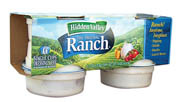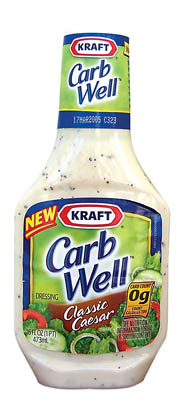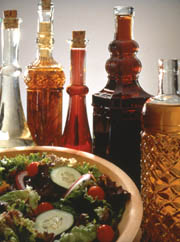
According to Mintel's Global New Products Database (GNPD, Chicago), some 260 new dressings and mayonnaise products were introduced in 2003 in the U.S. Additionally, 121 oils and 859 table and cooking sauces were launched last year. Many factors drive both new product development efforts and the nature of the products introduced.
For example, the low-carb movement has pushed many to turn toward salads. Since the induction phase of the Atkins diet advises against foods with higher carbohydrate levels (such as carrots and tomatoes), people are “beefing up” their salads with proteins from eggs and turkey to ham, bacon and cheese. Although these components turn a bland, leafy meal into something rich and filling, the addition of a creative dressing is needed to truly bring the meal to life.
According to the Association for Dressings and Sauces (Atlanta), a survey of 1,000 Americans revealed that salad dressings are more popular with women than men. Some 25% of women “love” salad dressing and use it more than any other condiment sauce. Their usage is strongest in the Northeast region of the U.S. Additionally, 81% of consumers aged 18 to 24 said they liked salad dressing the best of condiment sauces.
Although flavorful products (from the traditional to the new and exotic) draw consumers, there also are some health issues which may concern them.

Safety and Heart Health
Many who consume salads do so because they are perceived to be healthful, but both the types of fat present and microbial safety may be questioned.For example, trans fatty acids regularly have been in the news. Happily for salad lovers, the oils that form the basis of salad dressings usually are not hydrogenated and generally do not contain these types of unsaturated fats.
Manufacturers of gourmet products may look to olive oil as both a flavorful and healthy oil base. Producers in Egypt, Tunisia and even the U.S. now join traditional sources of olive oil, the countries of Italy, Spain, Greece and Portugal.
Other oils sport components that are of benefit to heart health. For example, sesame oil contains natural polyphenols that have been shown to be heart healthy. A proprietary blend of high oleic sunflower oil, sesame oil and rice bran oil was given “Healthy Oil” status by the German government several years ago.
On the flavor front, users have the option of buying sesame oil from toasted or untoasted seeds for a very different flavor profile. The toasted sesame oil can provide dressings and dips with an Oriental touch. Oils from tree nuts such as almonds, hazelnuts and walnuts have heart healthy properties and unique flavors.
Many consumers view salad dressings and mayonnaise-type products with caution in regards to microbial safety. However, commercial mayonnaises are one of the safest products in the marketplace. They have a low pH level and are manufactured from pasteurized eggs.
Organic acids, particularly sodium benzoate/benzoic acid and potassium sorbate/sorbic acid, may be used in both shelf-stable and refrigerated products to reduce risk of microbial spoilage. They are less important in food safety due to their relative ineffectiveness against pathogens. The salt forms (e.g., sodium benzoate, potassium sorbate) are more commonly formulated into products due to their greater solubility, although it is the undissociated acid forms (e.g., benzoic or sorbic acid) that are the effective microbial inhibitors. Reducing pH increases the amount of molecules in undissociated forms. Roughly the same antimicrobial effect is obtained with 0.05% benzoate at pH 3.0 as is 0.1% at pH 4.0.
The GNPD shows Unilever Bestfoods (Englewood Cliffs, N.J.) launched shelf-stable Wish-Bone Restaurant Style Raspberry Hazelnut Vinaigrette Dressing with sodium benzoate, sorbic acid and calcium disodium EDTA (a metal chelator) in the U.S. this spring. The product also contains pH-lowering distilled balsamic vinegar and citric acid. This summer, Unilever Canada (Toronto) launched Creamy Dijonnaise with sodium benzoate and the acidifiers citric and tartaric acid. Such “mayo-fusion” products are not limited to North America. For example, Mautner Markhof Feinkost (Vienna, Austria) just introduced Estragonaise Mayonnaise, with a “tarragon mustard and tomato ketchup flavor.” The preservative system also combines potassium sorbate with acidifiers such as vinegar, citric acid and ketchup.
In a related area, some gourmet product manufacturers have used flavorful, herb-infused oils as a dressing base. Herbs typically used include peppers, rosemary, thyme and garlic. Some of these infusions have the added benefit of containing antioxidants, which protect the product from oxidation and increase antioxidants in the diet.
Creamy Stability
An additional challenge for some dips and dressings is that the non-polar oil and aqueous vinegar or water phase must be mixed and remain stabilized--as economically as possible.Salad dressings, mayonnaise, dairy dips and many cooking sauces are oil-in-water (O/W) emulsions. Such products generally use stabilizer and emulsifier ingredients along with a homogenizing process to achieve desired finished product characteristics.
“Stokes Law says there are three basic factors influencing the stability of an emulsion," says Bruce Tharp, Ph.D.,Tharp's Food Technology (Wayne, Penn.). For O/W emulsions they are as follows:
1. Oil droplet size--the smaller the better,
2. Viscosity of the continuous water phase--the thicker the better, and,
3. Densities of the oil and water phases--the more similar the better.
Emulsifier ingredients decrease surface tension between a food's water and oil (and in some products, air) phases. The emulsifier molecule's hydrophilic (water-loving) portion orients itself in water, the lipophilic (lipid-loving) moiety in oil (or air). Ingredients from proteins to monoglycerides to sugar esters keep fat droplets from coalescing, by nature of their electrostatic charge and/or by physical (steric) mechanisms.
Stabilizer ingredients--through water mobility control and/or by increasing the water phase's viscosity--improve a product's texture and the stability of emulsion. Categories of stabilizers include proteins, hydrocolloid gums and starches, including certain maltodextrins.
The ability of an ingredient to stabilize a product both as an emulsifier and a thickener is not mutually exclusive. Gums such as propylene glycol alginate and Arabic gum work in both manners. However, Arabic gum adds relatively little viscosity, making it very useful in some applications, notes Susan Gurkin, application center director for a gum supplier.
Additionally, certain new varieties of pectins entering the marketplace also are amphiphilic in nature. Thus, they both emulsify and impact product thickness. “Pectins need a calcium salt in order to 'bridge' and form a gel structure. Such salts are generally not present in dressings,” Gurkin says. However, they would be of use in dairy-based dips and similar products where pectins' gelling ability can be controlled to create a desired texture, she adds.
Some modified starches and longer chain maltodextrins can do more than just thicken, as well.
“Starches are naturally hydrophilic and can bind large amounts of water, especially after gelatinization,” says Marlene Celis, technical service specialist with a starch supplier. Emulsifying starches are created by the addition of hydrophobic groups to starch polymers. Because of their duel property, emulsifying starches are able to interact with both water and oil, allowing them to function as egg-replacers in dressings and emulsified sauces. “By using lipophilic starches, a stable emulsion is achieved at a reduced cost, while also obtaining a product that is cholesterol-free,” Celis points out.
The cost of such additives is generally more than a product's base food components (e.g., vinegar or oil). Thus, getting the maximum performance from them helps save on overall formulation cost. One processing step, homogenization, is particularly important in obtaining the most effect for the least amount of stabilizer ingredient cost.

Equipment-ingredient Interactions
Homogenization equipment functions by applying shear to foods. The beneficial effects of shear include ingredient dispersion and oil droplet size reduction (to the 1-5µm range). Too little shear may make it appear as though inadequate levels of stabilizer were used (due to improper dispersion); and unstable emulsions result (from too large oil droplets and thin water-phase viscosity.)Too much shear can break apart viscosity-increasing ingredients. Shear also can provide a useful increase in viscosity.
The eventual impact of a homogenizing step on ingredient functionality depends on the ingredient under consideration. For example, “Microcrystalline cellulose (MCC) requires the high shear of a homogenizer,” says Tharp. Galactomannans (locust bean gum and to a lesser degree, tara gum) react synergistically with xanthan gum. Homogenizing these ingredients maximizes their interaction, he adds.
The theory behind this is relatively simple; homogenizing increases the surface area of molecules and exposes more reactive sites, increasing synergistic interactions.
For some emulsified products, an important step in getting the most out of ingredients is to pre-disperse--but not hydrate--stabilizers before the homogenization step. This can be accomplished by pre-blending the stabilizers with other dry ingredients such as polyols (e.g., sorbitol or polydextrose), with 68% solids high fructose corn syrup (i.e., “liquid sugar”) or with an equivalent of 16lbs. sugar in a gallon of water or oil.
A Comment on Equipment
The production of a high quality and economical emulsified product also involves choosing the right equipment, knowing its optimum settings and understanding its parameters and limitations.Homogenizers are designed to reduce the size of the disperse fat in the aqueous phase. End products with smaller fat droplets and better dispersion tend to be creamier, have better mouthfeel and are more stable than products containing larger droplets.
Several different types of equipment can be used to homogenize products. High shear mixers, colloid mills and high-pressure homogenizers are most common. Which one to use depends on the application, making a trade-off between energy usage versus required outcome or--to product developers in companies not inclined to add new equipment at the moment--what they have on-hand. See charts “Size vs. Pressure” and “The Right Tool for the Right Job.”
High-shear mixers, the simplest homogenization method, are used mainly for smaller batch sizes of low-viscosity products, or in a pre-mixing/pre-emulsifying step. Homogenization is accomplished by creating a shear gradient between a rotating rotor blade and a stator for particle size reduction and dispersion.
Colloid mills work well for salad dressings and mayonnaise. Mills work by creating share on food components as they flow between the rotor and stator, a space that is adjustable and allows adjustment of shear rates. A narrower space creates higher shear. Colloid mills produce emulsions with droplet sizes of 1 to 5µm.
As in most processing steps, ingredients and equipment can work in harmony, or they can interact “like oil and water.”